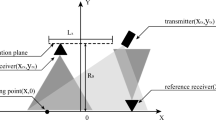Abstract
An equivalent system model (ESM) that can be used to calibrate a SAR system affected by both the effect of system errors and the Faraday rotation (FR) is proposed. This ESM contains only system-distortion-like parameters but includes a distortion matrix (DM) that is identical to the original, which contains the effects of both the system errors and the Faraday rotation angle (FRA). With this model, the conventional distributed-target-based (DT-based) algorithms which have not taken FR effect into account are readily applicable. The conditions on FRA for the successful application of DT-based algorithms are studied, and the results suggest that reliable estimates can be obtained for a well-designed system whose true system crosstalk level is lower than −20 dB provided that the mean FRA at the calibration site is within ±15° and that the FRA can be suitably modeled as Gaussian. Thus, the requirements on the crosstalk level or the FRA that are commonly employed in other calibration methods designed for data affected by FR are relaxed.
Similar content being viewed by others
References
Rignot E J, Zimmermann R, van Zyl J J. Spaceborne applications of P-band imaging radars for measuring forest biomass. IEEE Trans Geosci Remote Sens, 1995, 33: 1162–1169
Lopez-Sanchez J M, Hajnsek I, Ballester-Berman J D. First demonstration of agriculture height retrieval with PolInSAR airborne data. IEEE Geosci Remote Sens Lett, 2012, 9: 242–246
Guo S L, Li Y, Hong W, et al. Model-based target decomposition with the π/4 mode compact polarimetry data. Sci China Inf Sci, 2016, 59: 062307
Freeman A. Calibration of linearly polarized polarimetric SAR data subject to Faraday rotation. IEEE Trans Geosci Remote Sens, 2004, 42: 1617–1624
Touzi R, Shimada M. Polarimetric PALSAR calibration. IEEE Trans Geosci Remote Sens, 2009, 47: 3951–3959
Kimura H. Calibration of polarimetric PALSAR imagery affected by Faraday rotation using polarization orientation. IEEE Trans Geosci Remote Sens, 2009, 47: 3943–3950
Villa A, Iannini L, Giudici D, et al. Calibration of SAR polarimetric images by means of a covariance matching approach. IEEE Trans Geosci Remote Sens, 2015, 53: 674–686
van Zyl J J. Calibration of polarimetric radar images using only image parameters and trihedral corner reflector responses. IEEE Trans Geosci Remote Sens, 1990, 28: 337–348
Freeman A, van Zyl J J, Klein J D, et al. Calibration of stokes and scattering matrix format polarimetric SAR data. IEEE Trans Geosci Remote Sens, 1992, 30: 531–539
Klein J D. Calibration of complex polarimetric SAR imagery using backscatter correlations. IEEE Trans Aerosp Electron Syst, 1992, 28: 183–194
Touzi R, Livingstone C E, Lafontaine J R C, et al. Consideration of antenna gain and phase patterns for calibration of polarimetric SAR data. IEEE Trans Geosci Remote Sens, 1993, 31: 1132–1145
Quegan S. A unified algorithm for phase and cross-talk calibration of polarimetric data — theory and observations. IEEE Trans Geosci Remote Sens, 1994, 32: 89–99
Ainsworth T L, Ferro-Famil L, Lee Jong-Sen. Orientation angle preserving a posteriori polarimetric SAR calibration. IEEE Trans Geosci Remote Sens, 2006, 44: 994–1003
Goh A, Preiss M, Gray D, et al. Comparison of parameter estimation accuracy of distributed-target polarimetric calibration techniques. In: IEEE International Geoscience and Remote Sensing Symposium (IGARSS), Barcelona, 2007. 4175–4178
Zhang H, Lu W, Zhang B, et al. Improvement of polarimetric SAR calibration based on the Ainsworth algorithm for Chinese airborne PolSAR data. IEEE Geosci Remote Sens Lett, 2013, 10: 898–902
Meyer F J, Nicoll J B. Prediction, detection, and correction of Faraday rotation in full-polarimetric L-band SAR data. IEEE Trans Geosci Remote Sens, 2008, 46: 3076–3086
Gail W. A simplified calibration technique for polarimetric radars. In: Proceedings of IEEE International Geoscience and Remote Sensing Symposium (IGARSS), Tokyo, 1993. 2: 377–379
Freeman A, Saatchi S S. On the detection of Faraday rotation in linearly polarized L-band SAR backscatter signatures. IEEE Trans Geosci Remote Sens, 2004, 42: 1607–1616
Wright P A, Quegan S, Wheadon N S, et al. Faraday rotation effects on L-band spaceborne SAR data. IEEE Trans Geosci Remote Sens, 2003, 41: 2735–2744
Sandberg G, Eriksson L E B, Ulander L M H. Measurements of Faraday rotation using polarimetric PALSAR images. IEEE Geosci Remote Sens Lett, 2009, 6: 142–146
Wright P, Meadows P, Mack G, et al. Aden ALOS-PALSAR product verification. In: Proceedings of European Space Agency Special Publication (ESA SP), Rhodes, 2008. 664
Lavalle M, Solimini D, Pottier E, et al. Faraday rotation estimation from unfocussed raw data: analysis using ALOSPALSAR data. In: Proceedings of European Space Agency Special Publication (ESA SP), Frascati, 2009. 668
Bickel S H, Bates R H T. Effects of magneto-ionic propagation on the polarization scattering matrix. Proc IEEE, 1965, 53: 1089–1091
Wang Y T, Ainsworth T L, Lee J-S. Assessment of system polarization quality for polarimetric SAR imagery and target decomposition. IEEE Trans Geosci Remote Sens, 2011, 49: 1755–1771
Acknowledgements
This work was supported by State Key Program of National Natural Science of China (Grant No. 61430118).
Author information
Authors and Affiliations
Corresponding author
Additional information
Conflict of interest The authors declare that they have no conflict of interest.
Rights and permissions
About this article
Cite this article
Zhang, J., Hong, W. Equivalent system model for the calibration of polarimetric SAR under Faraday rotation conditions. Sci. China Inf. Sci. 61, 022301 (2018). https://doi.org/10.1007/s11432-016-9032-6
Received:
Revised:
Accepted:
Published:
DOI: https://doi.org/10.1007/s11432-016-9032-6




